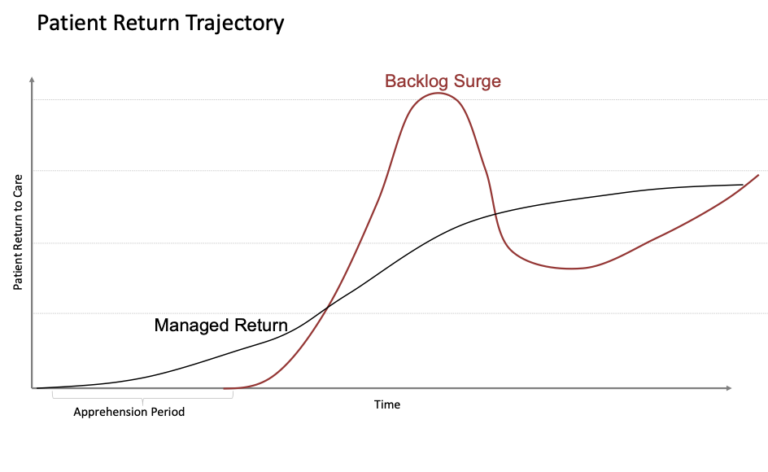From Reactive to Proactive Care Delivery: A Covid Blog
May 22, 2020 by Doug Dobie
Unintended Consequences
In New Mexico, a highly regarded cancer center received over 500 referrals per month in January and February of this year for treatments. In April, referrals were fewer than 100 patients, an 80% decrease, yet the two-year trend line reveals the need for cancer treatment did not diminish, seeking proper care did. Compounding the disquieting reality is the progressive characteristics of cancer.
Reverberations
While the surge of Covid19 cases heavily impacted a small percentage of dense urban hospitals mostly in New York City, the media images and public health messaging affected most of the 5,000 hospitals in this country causing unprecedented declines in patient visits. Throw in cancellation of elective surgeries, disallowing families to accompany patients, and shelter in place orders all but eliminated much needed preventative and early detection care. The need for care has not declined, it just been pushed out.

Apprehension
As of mid-May, we are in a period of apprehension vis-à-vis our health care providers. Hospitals cannot afford to sit back and wait for patients to return en masse; the better approach is to reach potential patients through a more intentional adoption cycle. Understanding flattening curves is now part of our collective zeitgeist, our health system is faced with an ominous counter surge and will need to get in front of it, alleviating apprehension, to flattened it.
Urge to Prevent the Surge
Overcoming patient apprehension requires a multi-faceted communication strategy with built-in surge protectors. The strategy contemplates public health policy, physical location safety, hospital administration and clinician alignment and right tone and tenor of the messaging itself. For surge protection, the care provider will need to define segments most in need and target them with relevant and specific messaging.
- State and Local Public Health officials: This should be an awareness campaign for specific chronic conditions, most notably cancer as discussed earlier. Further, elective surgeries which are managed and scheduled, need to be broadcast state-wide with a public health stamp of reassurance.
- The hospital or physician offices must appear safe and secure. In a hospital, “proof points” such as temporary facilities, separate entrances, walled-off areas, ubiquitous personal protective equipment, glass sneeze guards, careful management visitors and family members are the optics of reassurance.
- Inevitably, tensions between hospital leadership and patient-facing care providers have surfaced during the pandemic. It is undeniable that health professionals were placed in dangerous and difficult circumstances caring for Covid19 patients. However, a more pervasive threat across the entire health system has been the vast number of furloughed or laid-off clinicians. Hospital leadership and clinical staff need to reach out to their community personally – to reassure specific patient populations that safe, high-quality care is available now.
- The communication strategy needs to feel organic and genuine. Actual health care professionals reaching out and letting patients know its safe to seek the care they need. Reassure patient populations by providing personal antidotes from other patients who have successfully received care recently. Hospitals will align messaging with its patient-facing provider network supplying them with daily updates and success stories.
Alleviate Apprehension
A patient micro segment is finding its way back to receiving care recently, slightly above the admittance low points of mid-April. However, it is not enough nor is it necessarily the most at-risk populations. Health provider need to develop a patient condition segmentation strategy with specific positioning, messaging and call to action for each audience. Further, instill a multi-faceted approach partnering with community leaders, associations, and non-profit service providers to offer trusted advice and reassurance. Do not try to go it alone. Build state, local and community level support; align messaging and proof points and speak to specific audiences. Healthcare providers must catalyze the patient return to care curve or be faced the challenges of a pent-up surge of patients with dangerously advanced conditions.
Doug Dobie, CEO, Dobie Associates. Healthcare, Technology, Public Safety Consulting.
www.dobieassociates.com; Aurore, Strategy Frameworks and Analytics solution provider @auroreinc.com